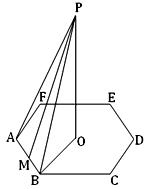Subscribe to our ▶️ YouTube channel 🔴 for the latest videos, updates, and tips.
Volume and Surface Area of a Pyramid
Formula of volume and surface area of a pyramid are used to solve the problems step-by-step with the detailed explanation.
Worked-out examples on volume and surface area of a pyramid:
1. A right pyramid on a square base has four equilateral triangles for its four other faces, each edge being 16 cm. Find the volume and the area of whole surface of the pyramid.
Solution:

Let the square WXYZ be the base of the right pyramid and its diagonal WY and XZ intersect at O. If OP be perpendicular to the plane of the square at O, then OP is the height of the right pyramid.
By question, lateral faces of the pyramid are equilateral triangles; hence,
PW = WX = XY = YZ = ZW = 16 cm.
Now, from the right-angled ∆ WXY we get,
WY² = WX² + XY²
or, WY² = 16² + 16²
or, WY² = 256 + 256
or, WY² = 512
or, WY = √512
Therefore, WY = 16√2
Therefore, WO = 1/2 ∙ WY = 8√2
Again OP is perpendicular to the plane of the square WXYZ at O; hence, OP ┴ OW.
Therefore, from the eight angled triangle POW we get,
OP² + OW² = PW²
or, OP² = PW² - OW²
or, OP² = 16² - (8√2)²
or, OP² = (8√2)²
Therefore, OP = 8√2
Now, draw OE ┴ WX; then, OE = 1/2 XY = 8 cm.
Join PE,
Clearly, PE is the slant height of the right pyramid.
Since OP ┴ PE,
Hence from the right angle triangle POE we get,
PE² = OP² + OE²
or, PE² = (8√2)² + 8²
or, PE² = 128 + 64
or, PE² = 192
Therefore, PE = 8√3
Therefore, the required volume of a right pyramid = 1/3 × (area of the square WXYZ) × OP
= 1/3 × 16² × 8√2 cu. cm.
= 1/3 ∙ 2048√2 cu. cm.
And area of its whole surface
= 1/2 (perimeter of square WXYZ) × PE + area of square WXYZ.
= [1/2 ∙ 4 ∙ 16 ∙ 8√3 + 16²] sq. cm.
= 256(√3 + 1) sq. cm.
2. The base of a right pyramid is a regular hexagon each of whose sides is 8 cm. and the lateral faces are isosceles triangles whose two equal sides are 12 cm. each.
Find the volume of the pyramid and the area of all its faces.
Solution:

Let O be the centre of the regular hexagon ABCDEF, the base of the right pyramid and P, the vertex of the pyramid. Join PA, PB, OB and PM where M is the mid-point of AB.
Then, OP is the height and PM, the slant height of the pyramid.
According to the question, AB = 8 cm. and
PA = PB = 12 cm; hence, AM = 1/2 ∙ AB = 4 cm.
Clearly, PM ┴ AB, hence from the right angled ∆ PAM we get ,
AM² + PM² = PA²
or, PM² = PA² - AM²
or, PM² = 12² - 4²
or, PM² = 144 - 16
or, PM² = 128
Therefore, PM = 8√2
Again, OP is perpendicular to the plane of the hexagon ABCDEF at O; hence OP ┴ OB.
Therefore, from the right angled ∆ POB we get ,
OP² + OB² = PB²
OP² = PB² - OB²
or, OP² = 12² - 8² (Since OB = AB = 8 cm)
or, OP² = 144 - 64
or, OP² = 80
Therefore, OP = 4√5.
Now, the area of the base of the pyramid = area of the regular hexagon ABCDEF
= {(6 ∙ 8²)/4} cot (π/6) [Since, the area of regular polygon of n sides = {(na²)/4} cot (π/n), a being the length of a side].
= 96√3 sq. cm.
Therefore, the required volume of the pyramid
= 1/3 × ( area of the the hexagagon ABCDEF) × OP
= 1/3 × 96√3 × 4√5 cu. cm.
= 128 √15 cu.cm.
And the area of all its faces
= area of the slant surfaces + area of the base
= 1/2 × perimeter of the base × slant height + area of hexagon ABCDEF
= [1/2 × 6 × 8 × 8√2 + 96√3] sq. cm.
= 96 (2√2 + √3] sq. cm.
● Mensuration
- Formulas for 3D Shapes
- Volume and Surface Area of the Prism
- Worksheet on Volume and Surface Area of Prism
- Volume and Whole Surface Area of Right Pyramid
- Volume and Whole Surface Area of Tetrahedron
- Volume of a Pyramid
- Volume and Surface Area of a Pyramid
- Problems on Pyramid
- Worksheet on Volume and Surface Area of a Pyramid
- Worksheet on Volume of a Pyramid
11 and 12 Grade Math
From Volume and Surface Area of a Pyramid to HOME PAGE
Didn't find what you were looking for? Or want to know more information about Math Only Math. Use this Google Search to find what you need.


New! Comments
Have your say about what you just read! Leave me a comment in the box below. Ask a Question or Answer a Question.